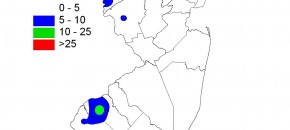There have been no new reports of late blight in New Jersey this past week. Late blight was reported in Northeast OH, Western NY and Lancaster, PA this past week. The extremely hot, dry weather this week throughout NJ has most likely reduced the immediate threat of late blight, but growers should remain cautious because the pathogen could […]
Continue reading...Tomato Disease Forecasting Report 7-19-13
7-19-13 Tomato Report – Click to Download Disease severity values (DSVs) for early blight, septoria leaf spot, and tomato anthracnose development are determined daily based on leaf wetness (due to rainfall, dew) and air temperature. On a daily basis DSV values can range from 0 to 4 where 0 = no chance for disease development […]
Continue reading...Potato Disease Forecasting Report 7-19-13
Potato Disease Forecasting Report 7-19-13 – Click to Download We will be tracking DSVs for Late blight development and calculating P-days for initiating the first early blight fungicide application. The first late blight fungicide application is recommended once 18 DSVs accumulate from green row. Green row typically occurs around the first week in May in southern […]
Continue reading...BMSB Populations in Mid-July

BMSB populations are significantly higher than last year and unsprayed fruit is already damaged. Fruit harvested (mid-season assessment) around July 4 in a research trial under light management had very early season injury as well as recent feeding damage. Some of this is due to the wet June we experienced which reduced the effectiveness of treatments, but […]
Continue reading...FDA Releases FSMA Factsheets for Farmers
FDA is expanding its outreach to small- and medium-size growers to address questions that have arisen since the proposed rule was issued in January 2013. According to Michael Taylor, Deputy Commissioner for Foods and Veterinary Medicine, FDA expects and welcomes questions that arise during the rulemaking process. In a new interview, he emphasizes that FDA […]
Continue reading...NJDA Plant Laboratory Offers Growers Mycotoxin Testing
The recent stretch of unusual rainy weather raises the potential of mycotoxin contamination in small grains, and other field or forage feed crops. Grain growers may be affected by price discounts and/or restricted markets. Mycotoxin contamination in animal feed and forage can lead to feed refusal, reduced productivity (reduced production of eggs, milk, and weight […]
Continue reading...